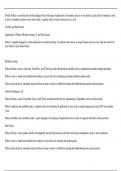Summary
Summary Python theory
- Course
- Institution
This note appears to be handwritten, with concise, neatly organized points. It likely includes key information or important reminders. The handwriting is clear and legible, making it easy to read and understand.
[Show more]



